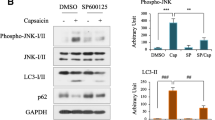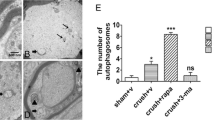Summary
Autophagy acts as an important homoeostatic mechanism by degradation of cytosolic constituents and plays roles in many physiological processes. Recent studies demonstrated that autophagy can also regulate the production and secretion of the proinflammatory cytokine interleukin-1β (IL-1β), which plays a critical role in the development and maintenance of neuropathic pain. In the present study, the paw withdrawal threshold (PWT) and paw withdrawal latency (PWL) were significantly decreased after spinal nerve ligation (SNL), and the changes were accompanied by inhibited autophagy in the spinal microglia and increased mRNA and protein levels of IL-1β in the ipsilateral spinal cord. We then investigated the antinociceptive effect of rapamycin, a widely used autopahgy inducer, on SNL-induced neuropathic pain in rats and found that treatment with intrathecal rapamycin significantly attenuated the mechanical allodynia and thermal hyperalgesia. Moreover, rapamycin significantly enhanced autophagy in the spinal microglia, whereas it reduced the mRNA and protein levels of IL-1β in the ipsilateral spinal cord. Our results showed that rapamycin could ameliorate neuropathic pain by activating autophagy and inhibiting IL-1β in the spinal cord.
Similar content being viewed by others
References
Baron R, Binder A, Wasner G. Neuropathic pain: diagnosis, pathophysiological mechanisms, and treatment. Lancet Neurol, 2010, 9(8):807–819
Mizushima N, Komatsu M. Autophagy: renovation of cells and tissues. Cell, 2011, 147(4):728–741
Liu CL, Chen S, Dietrich D, et al. Changes in autophagy after traumatic brain injury. J Cereb Blood Flow Metab, 2008, 28(4):674–683
Sadasivan S, Dunn WJ, Hayes RL, et al. Changes in autophagy proteins in a rat model of controlled cortical impact induced brain injury. Biochem Biophys Res Commun, 2008, 373(4):478–481
Zhang YB, Li SX, Chen XP, et al. Autophagy is activated and might protect neurons from degeneration after traumatic brain injury. Neurosci Bull, 2008, 24(3):143–149
Smith CM, Chen Y, Sullivan ML, et al. Autophagy in acute brain injury: feast, famine, or folly? Neurobiol Dis, 2011, 43(1):52–59
Kanno H, Ozawa H, Sekiguchi A, et al. The role of autophagy in spinal cord injury. Autophagy, 2009, 5(3):390–392
Chen HC, Fong TH, Lee AW, et al. Autophagy is activated in injured neurons and inhibited by methylprednisolone after experimental spinal cord injury. Spine, 2012, 37(6):470–475
Berliocchi L, Russo R, Maiaru M, et al. Autophagy impairment in a mouse model of neuropathic pain. Mol Pain, 2011, 7:83
Levine B, Mizushima N, Virgin HW. Autophagy in immunity and inflammation. Nature, 2011, 469(7330):323–335
Saitoh T, Fujita N, Jang MH, et al. Loss of the autophagy protein Atg16L1 enhances endotoxin-induced IL-1beta production. Nature, 2008, 456(7219): 264–268
Harris J, Hartman M, Roche C, et al. Autophagy controls IL-1beta secretion by targeting pro-IL-1beta for degradation. J Biol Chem, 2011, 286(11):9587–9597
Nakahira K, Haspel JA, Rathinam VA, et al. Autophagy proteins regulate innate immune responses by inhibiting the release of mitochondrial DNA mediated by the NALP3 inflammasome. Nat Immunol, 2011, 12(3):222–230
Shi CS, Shenderov K, Huang NN, et al. Activation of autophagy by inflammatory signals limits IL-1beta production by targeting ubiquitinated inflammasomes for destruction. Nat Immunol, 2012, 13(3):255–263
Ren K, Torres R. Role of interleukin-1beta during pain and inflammation. Brain Res Rev, 2009, 60(1):57–64
Kiguchi N, Kobayashi Y, Kishioka S. Chemokines and cytokines in neuroinflammation leading to neuropathic pain. Curr Opin Pharmacol, 2012, 12(1):55–61
Wolf G, Gabay E, Tal M, et al. Genetic impairment of interleukin-1 signaling attenuates neuropathic pain, autotomy, and spontaneous ectopic neuronal activity, following nerve injury in mice. Pain, 2006, 120(3):315–324
Raught B, Gingras A C, Sonenberg N. The target of rapamycin (TOR) proteins. Proc Natl Acad Sci USA, 2001, 98(13):7037–7044
Wen YD, Sheng R, Zhang LS, et al. Neuronal injury in rat model of permanent focal cerebral ischemia is associated with activation of autophagic and lysosomal pathways. Autophagy, 2008, 4(6):762–769
He Y, Wan S, Hua Y, et al. Autophagy after experimental intracerebral hemorrhage. J Cereb Blood Flow Metab, 2008, 28(5):897–905
Alirezaei M, Kemball CC, Whitton JL. Autophagy, inflammation and neurodegenerative disease. Eur J Neurosci, 2011, 33(2):197–204
Shih MH, Kao SC, Wang W, et al. Spinal cord NMDA receptor-mediated activation of mammalian target of rapamycin is required for the development and maintenance of bone cancer-induced pain hypersensitivities in rats. J Pain, 2012, 13(4):338–349
Sakura S, Kirihara Y, Muguruma T, et al. The comparative neurotoxicity of intrathecal lidocaine and bupivacaine in rats. Anesth Analg, 2005, 101(2):541–547
Kim SH, Chung JM. An experimental model for peripheral neuropathy produced by segmental spinal nerve ligation in the rat. Pain, 1992, 50(3):355–363
Norsted GE, Codeluppi S, Gregory JA, et al. Mammalian target of rapamycin in spinal cord neurons mediates hypersensitivity induced by peripheral inflammation. Neuroscience. 2010, 169(3):1392–1402
Yan W, Zhang H, Bai X, et al. Autophagy activation is involved in neuroprotection induced by hyperbaric oxygen preconditioning against focal cerebral ischemia in rats. Brain Res, 2011, 1402:109–121
Myers B, Greenwood-Van MB. Elevated corticosterone in the amygdala leads to persistent increases in anxiety-like behavior and pain sensitivity. Behav Brain Res, 2010, 214(2):465–469
Hargreaves K, Dubner R, Brown F, et al. A new and sensitive method for measuring thermal nociception in cutaneous hyperalgesia. Pain, 1988, 32(1):77–88
Hirai K, Aliev G, Nunomura A, et al. Mitochondrial abnormalities in Alzheimer’s disease. J Neurosci, 2001, 21(9):3017–3023
Kawasaki Y, Xu ZZ, Wang X, et al. Distinct roles of matrix metalloproteases in the early- and late-phase development of neuropathic pain. Nat Med, 2008, 14(3): 331–336
Ravikumar B, Sarkar S, Davies JE, et al. Regulation of mammalian autophagy in physiology and pathophysiology. Physiol Rev, 2010, 90(4):1383–1435
Guo Y, Wang J, Wang Z, et al. Melatonin protects N2a against ischemia/reperfusion injury through autophagy enhancement. J Huazhong Univ Sci Technolog [Med Sci], 2010, 30(1):1–7
Zhang E, Yi MH, Ko Y, et al. Expression of LC3 and Beclin 1 in the spinal dorsal horn following spinal nerve ligation-induced neuropathic pain. Brain Res, 2013, 1519: 31–39
Zhou X, Zhou J, Li X, et al. GSK-3beta inhibitors suppressed neuroinflammation in rat cortex by activating autophagy in ischemic brain injury. Biochem Biophys Res Commun, 2011, 411(2):271–275
Schafers M, Sorkin L. Effect of cytokines on neuronal excitability. Neurosci Lett, 2008, 437(3):188–193
Mcmahon SB, Cafferty WB, Marchand F. Immune and glial cell factors as pain mediators and modulators. Exp Neurol, 2005, 192(2):444–462
Harris J. Autophagy and IL-1 family cytokines. Front Immunol, 2013, 4:83
Shi G, Shi J, Liu K, et al. Increased miR-195 aggravates neuropathic pain by inhibiting autophagy following peripheral nerve injury. Glia, 2013, 61(4):504–512
Author information
Authors and Affiliations
Corresponding authors
Additional information
The two authors contributed equally to the project.
This project was supported by grants from the National Natural Science Foundation of China (Nos. 31100801 and 81200858).
Rights and permissions
About this article
Cite this article
Feng, T., Yin, Q., Weng, Zl. et al. Rapamycin ameliorates neuropathic pain by activating autophagy and inhibiting interleukin-1β in the rat spinal cord. J. Huazhong Univ. Sci. Technol. [Med. Sci.] 34, 830–837 (2014). https://doi.org/10.1007/s11596-014-1361-6
Received:
Revised:
Published:
Issue Date:
DOI: https://doi.org/10.1007/s11596-014-1361-6




